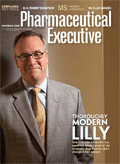Docs Rock the Vote
Pharmaceutical Executive
Medical journal advertising takes center stage at the sixth-annual Doctor's Choice Awards
The pharma industry is filled with awards that take note of the best and brightest companies have to offer. But there's one pharma award that marketing agencies seem to especially appreciate—and that's because doctors dictate the vote. This year's Doctors' Choice Awards, sponsored by the Association of Medical Media (formerly the Association of Medical Publishers), was judged by nearly 6,000 docs, who examined 327 professional ads in 13 product categories. The winning journal ads were showcased at a New York Palace Hotel gala in September. Ads were judged on their ability to communicate clearly and quickly, help with clinical decisions, prompt physicians to seek more information or re-examine treatment, generate interest, add to information provided by company sales reps, and underscore the value of the promoted product.

The Doctors' Choice Awards winners included (from top left): Pfizer's Chantix by Euro RSCG Life LM&P; Merck's Gardasil by JUICE; Alcon's Vigamox by Corbett Worldwide; and Takeda's Rozerem by Abelson-Taylor
"I think it is the most meaningful because it's not a jury of our peers or a popularity contest," says Alan Topin, president of Topin & Associates, whose agency stole the show, winning three awards for its four-page Dusa ClindaReach (Clindamycin) launch ad for acne. "[These awards] deal with ethics—so in that sense we are triply delighted with our work."
For Robin Shapiro, senior vice president and executive creative director at Corbett Worldwide Healthcare Communications, the Doctors' Choice Awards takes the temperature of an idea's ability to break through the competitive clutter. "The fact that physicians choose the winners makes this show a favorite of many clients," she says.
Find the Winning Formula
Reflecting the broader trend in drug development, an ad took first place in two categories for two different indications for the first time this year. That campaign—produced by GSW Worldwide for Lilly's Cymbalta (duloxetine)—struck a chord with physicians specializing in gastroenterology and neurology.
Dean Tepper, senior vice president and group creative director of GSW, says that there are two reasons why the Cymbalta ads "communicated the brand's benefits in a compelling way": the target patient is clearly identified through the casting, and the use of four successive single page ads offer a chance to tell the brand's story. "It helped communicate the various problems patients face while also showing the resolution," says Tepper.
Corbett took home two awards at the event, one for the "pink eye" treatment Vigamox (moxifloxacin), which doctors said had immediate appeal—and which Shapiro said was steeped in solid branding principles: "Our goal is to go beyond the campaign idea to build proprietary brand identities. The Vigamox work is an example of both instant communication and a proprietary brand identity."
Shapiro also mentions that today's pharma promotion has to do a better job of communicating information, rather than just selling product. "Physicians are looking to reclaim control over their lives," he says. "They are less receptive to sales calls, and increasingly look to receive information on their own time and their own terms."
According to David Paragamian, president of Euro RSCG Life LM&P, even for professional marketers, it is more important than ever to look beyond what was once considered "narrow" communication. "We believe that communication that works is integrated across target audiences, connecting the healthcare professional, the patient, in some therapeutic areas the loved ones, and, of course, payers," he says. "It's also integrated across communication channels, such as print and online."
As for next year's event, William Castagnoli, director of the Doctors' Choice Awards, advises pharmaceutical and biotech companies to step out of the shadow of me-too drugs and hew to the basics. "I would urge advertisers to look for new information you can deliver. Then dress it up. Why would a doctor look through a journal when he has a lot of other things to do? He is looking to learn something new," Castagnoli says. "The wining formula is to deliver information clearly, and then create a graphic that directs attention."
Brittany Agro is Pharmaceutical Executive's assistant editor. She can be reached at bagro@advanstar.com
The Misinformation Maze: Navigating Public Health in the Digital Age
March 11th 2025Jennifer Butler, chief commercial officer of Pleio, discusses misinformation's threat to public health, where patients are turning for trustworthy health information, the industry's pivot to peer-to-patient strategies to educate patients, and more.
Navigating Distrust: Pharma in the Age of Social Media
February 18th 2025Ian Baer, Founder and CEO of Sooth, discusses how the growing distrust in social media will impact industry marketing strategies and the relationships between pharmaceutical companies and the patients they aim to serve. He also explains dark social, how to combat misinformation, closing the trust gap, and more.
